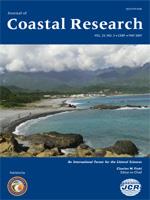During the last 50 years, the Spanish Mediterranean coast has experienced a massive influx of tourism that has affected the ecosystems adjacent to the coastline, triggering processes of regression and fragmentation. The changes between 1956 and 1996 are characterized and quantified here in a part of the coast next to Torredembarra (NE Spain) that occupies 470 ha. For this zone, maps of vegetation for 1956, 1985, and 1996 were prepared with a common legend of 14 units. A numerical matrix was generated with the Geographic Information System to detect the spatial-temporal variations between units; furthermore, several landscape indicators and parameters were assessed. All of them show evidence of the accelerated substitution of an agricultural landscape and extensive areas of coastal vegetation by an urban landscape: agricultural land diminished by 64.3% and coastal vegetation by 55.3%, whereas urban areas increased by 2326.5%. If present conditions persist, in the next 30 years urban areas will occupy 87% to 100% of the territory. We also emphasize the importance of a reserve zone (natural area of interest) of 45 ha in the conservation of some coastal natural habitats listed in directive 92/43/EC. At present, this reserve creates a “buffer” effect that restrains the regression of these habitats and shows in addition a spatial continuity lacking in unprotected sectors. We also warn of the risk of disappearance of unprotected natural habitats in the short term due to urban growth and summer tourism.
How to translate text using browser tools
1 January 2008
Diachronic Cartography and Spatial Pattern Assessment in Coastal Habitats: The Case of Torredembarra (Northeast Spain)
G. A. Reina-Rodríguez,
I. Soriano
ACCESS THE FULL ARTICLE

Journal of Coastal Research
Vol. 24 • No. sp1
January 2008
Vol. 24 • No. sp1
January 2008
conservación
conservation
crecimiento urbano
Cuenca Mediterránea
fragmentación
fragmentation
GIS




